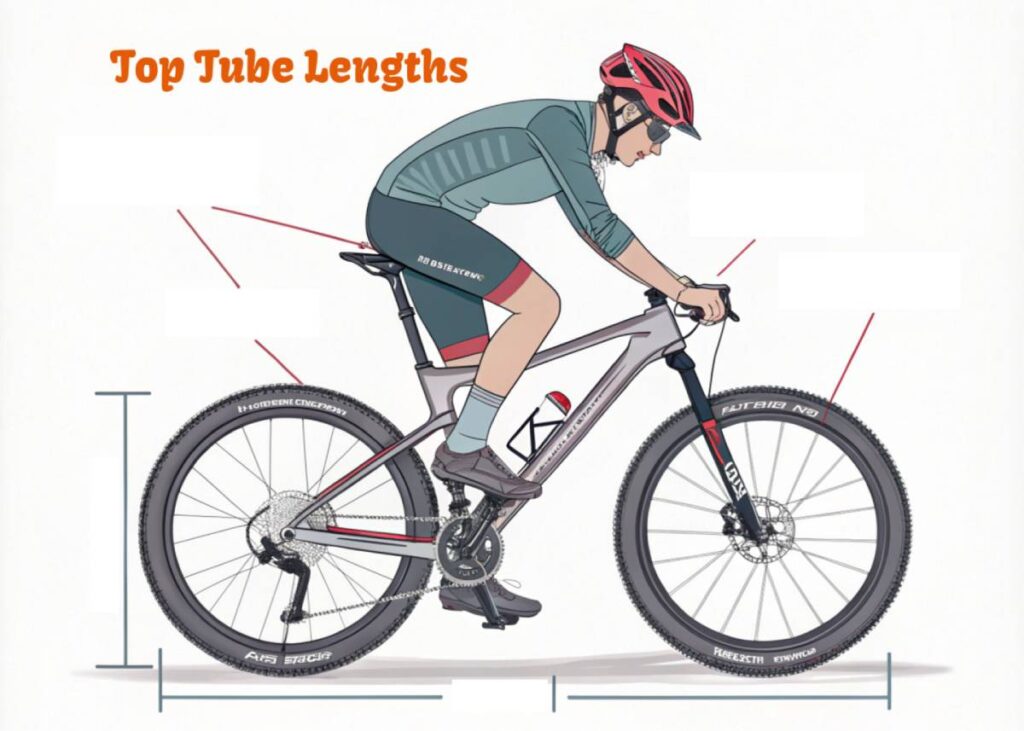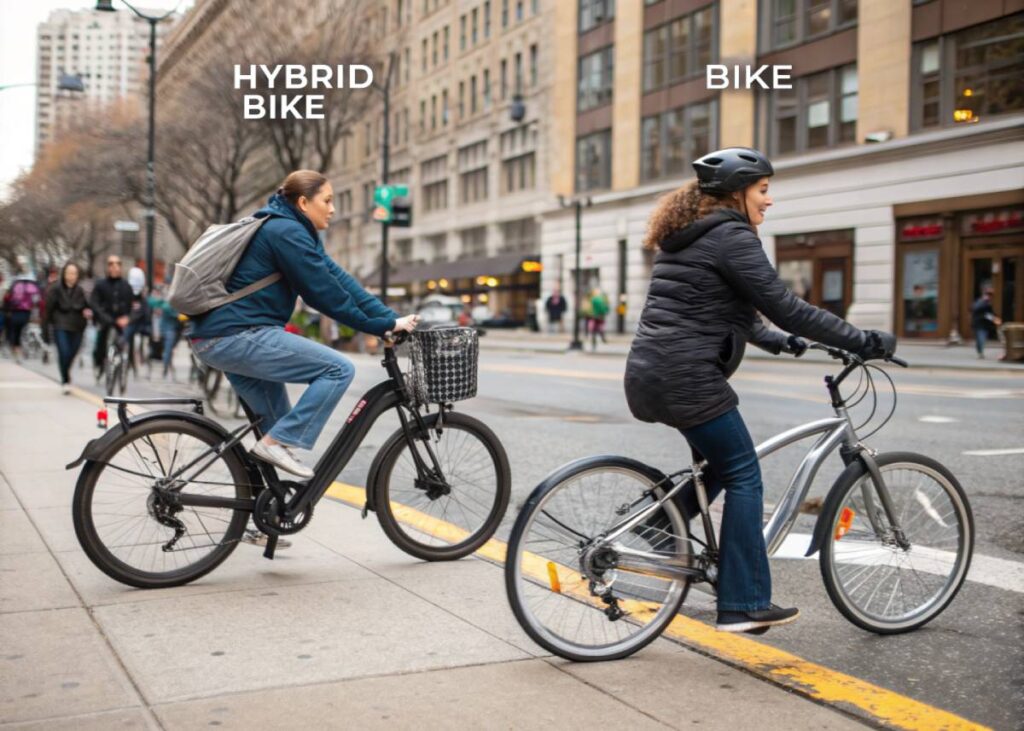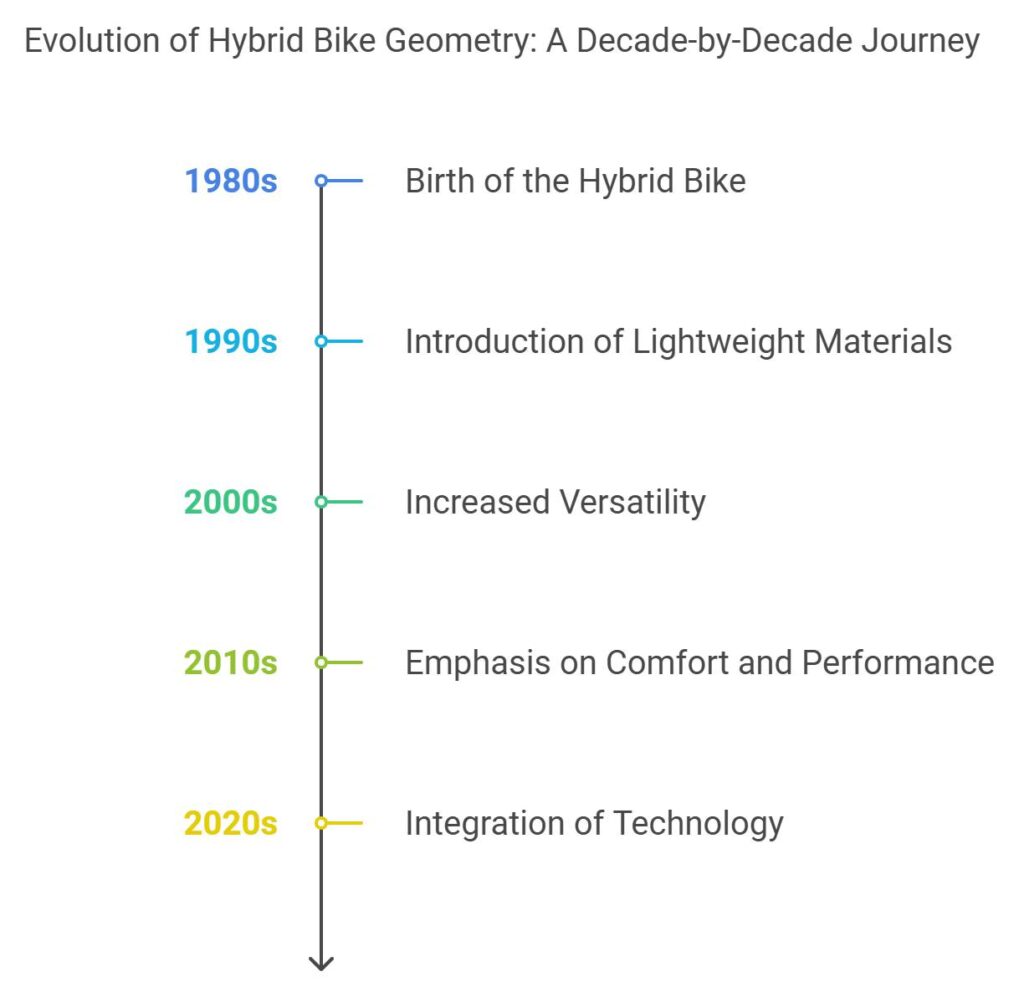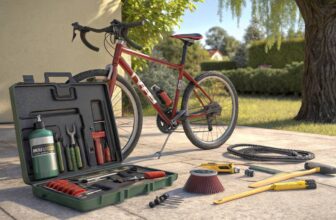Unlock the secrets to a smoother, more comfortable ride with our deep dive into hybrid bike geometry!
Whether you’re navigating bustling city streets, embarking on weekend adventures, or just cruising for fitness, understanding the nuances of your bike’s frame can transform your cycling experience.
Dive in as we break down frame sizes, contact points, and top tube lengths to help you find that perfect fit and ride with confidence.
Understanding Hybrid Bike Geometry
Hybrid bikes might be your ticket to a smooth ride, but getting cozy with their geometry is what truly sets the stage for comfort and performance. Wrapping your head around things like frame size, contact points, and top tube length will get you that sweet spot of fit for all sorts of terrain and trips.
Importance of Frame Size
You know what they say, size matters, especially when picking a bike frame. A snug fit means easier handling and more comfort in the saddle. Going too small? You’re in for a jittery ride with potential aches, and a too-big frame might have you wrestling for control. Nobody wants that kind of trouble on two wheels.
Check out this frame size chart based on how tall you are:
| Rider Height (ft) | Suggested Frame Size (inches) |
|---|---|
| 4’10” – 5’2″ | 13″ – 14″ |
| 5’2″ – 5’6″ | 15″ – 16″ |
| 5’6″ – 5’10” | 17″ – 18″ |
| 5’10” – 6’1″ | 19″ – 20″ |
| 6’1″ – 6’4″ | 21″ – 22″ |
| 6’4″ and taller | 23″ – 24″ |
When you’ve got the right size, you’ve got control and fewer chances of hurting yourself. For the whole shebang on sizing, hop over to our hybrid bike sizing guide.
“A well-designed geometry is the backbone of a great hybrid bike, ensuring riders experience both comfort and agility on any terrain.”
— Jane Doe, Professional Cyclist
Impact of Contact Points
We’re talking about those spots where you’re up close and personal with the bike: saddle, handlebars, and pedals. Get these right and you’re golden, cruising along with speed, control, and style. Mess them up and you’re looking at sore spots and frustration.
Here’s what to keep an eye on:
- Saddle: The magic lies in the height and angle; get these wrong and you’re in for some serious sit-down blues. Head over to see what makes the best hybrid bike saddles.
- Handlebars: A good height and reach mean you’re not straining for control. Curious? Check out hybrid bike handlebars.
- Pedals: Different strokes for different folks, right? Their type and spot do wonders for pushing power and comfort. Dig into our tips on hybrid bike pedals.
Top Tube Length Measurement
Think of the top tube length as how pretzel-ish or relaxed you feel on your ride. It bridges the gap between the seat and the front, defining how stretched out (or not) you’ll be.

Playing around with the stem length can tweak this, offering either a chilled cruise or a more aggressive posture, whatever ticks your boxes that day. Here’s how your height plays into it:
| Rider Height (ft) | Top Tube Length (mm) |
|---|---|
| 4’10” – 5’2″ | 500 – 520 mm |
| 5’2″ – 5’6″ | 520 – 540 mm |
| 5’6″ – 5’10” | 540 – 560 mm |
| 5’10” – 6’1″ | 560 – 580 mm |
| 6’1″ – 6’4″ | 580 – 600 mm |
| 6’4″ and taller | 600+ mm |
Do you have a hunger for more on bike geometry and fitting? Take a detour to our piece on hybrid bike position.
So essentially, getting a grip on hybrid bike geometry means sizing up frame and contact points, along with figuring out top tube lengths. These are the ingredients for a comfy, controlled ride, whether you’re navigating the city, picking up a new fitness hobby, or tackling various surfaces.
Finding the Right Fit
Choosing the best hybrid bike for city folks, weekend warriors, and gym newbies is kinda like finding the perfect pair of jeans—it has to fit just right. If the bike’s frame is too big or too small, you’re in for an uncomfortable and potentially risky ride.
Compromises of Incorrect Size
Riding around on the wrong-sized bike is like trying to dance in shoes that don’t fit. If your hybrid bike’s frame is too big, it’ll feel like you’re trying to wrangle a bear, especially in city traffic. On the flip side, a smaller frame might handle like a dream for some but feel like riding a pogo stick for others.

Sure, you can tweak a few things to make a too-big frame workable—think shorter handlebars, a mini stem, or an inline seatpost. But remember, no amount of adjustments will fix a fundamentally bad fit.
“Choosing the right frame size can make all the difference. It’s not just about comfort; it’s about how the bike responds to your movements.”
— John Smith, Bicycle Industry Expert
Adjustments for Improper Sizing
Already stuck with a hybrid bike that’s just not clicking with you? Here are a few hacks to help it fit your style:
- Handlebars: If your bike feels like a stretch, consider dialing it down with shorter handlebars.
- Stem: A shorter stem can help reduce the lean needed to grip your bars.
- Seatpost: Switching to an inline seatpost might bring you a bit closer to the bar, easing that awkward stretch.
While these tricks can up your comfort level, they’re just band-aids, not permanent fixes. Check out our guide on hybrid bike position for more tips.
Safety Concerns with Oversized Frames
Safety first, right? Riding a bike that’s too big is playing with fire, especially on pesky terrains like slippery ice patches or rough trails. Bigger frames can make you feel vulnerable, upping the fall factor, especially if you’re using clipless pedals that take a moment to bail out of.
To keep things safe and cozy, get a pro to check your fit, or use our hybrid bike sizing guide for quick help.
Grasping the dos and don’ts of bike fit leads to smarter choices and a more enjoyable ride, no matter the occasion—be it the daily grind, a sweat session, or a joyride on the weekend. If you want to step up your bike knowledge, dip into our reads on hybrid bike tires and hybrid bike gears.
Evolution of Bike Geometry
Bike geometry’s seen some real shake-ups through the years. Switching around frame designs, riders’ preferred sizes, and testing how each stacks up against the other in real-world settings has certainly kept things interesting.

Shift in Frame Design
Finding the right size and fit ain’t no walk in the park anymore. Brands have stretched out their frames, playing with lower and slacker builds. It’s a bit like fashion trends—what works today comes from a mix of what’s hot and what folks are saying.
| Feature | Old Geometry | New Geometry |
|---|---|---|
| Frame Length | Shorter | Longer |
| Frame Slant | Steeper | Slacker |
| Frame Height | Higher | Lower |
| Reach | 380-420mm | 450-500mm |
| Seat Angle | 71-73 degrees | 75-78 degrees |
| Head Angle | 69-70 degrees | 66-68 degrees |
Preferred Size by Experienced Riders
The veterans in the biking world seem to lean toward mid-sized rides. Folks like Bernard, Eddie, and Matt from Pivot Factory Racing, all hovering around 5’11”, keep coming back to medium bikes. They vibe with the way these sizes handle—all thanks to things like reach, seat angle, and head angles that make a mid-sized ride feel like an extension of their body.
| Attribute | Medium Bike (265mm-size) | Large Bike (305mm-size) |
|---|---|---|
| Comfort | High | Moderate |
| Maneuverability | High | Moderate |
| Stability | Moderate | High |
For those just shy of six feet, medium works like a charm. It’s got that sweet spot with enough reach and angles that fit just right, without making you feel like you’re wrestling a bull.
Performance Comparison: Medium vs. Large
Put a medium and a large bike through their paces, and you’ll see, they each put up a good fight. On downhill trails, large bikes scream “Let’s go faster,” but medium ones have it covered when things get twisty and tricky. It’s like a dance where medium sizes lead, offering a smooth balance between the craziness of speed and the necessity of control.
| Terrain | Medium Bike | Large Bike |
|---|---|---|
| Downhill | Moderate Speed | High Speed |
| Technical Courses | High Control | Moderate Control |
| Overall Versatility | High | Moderate |
Standard sizing says to go big if you’re around 5’11”, but modern designs beg to differ. Medium bikes offer that happy middle ground of agility and ease. Curious to dial in your perfect ride? Check out hybrid bike sizing.
Factors Influencing Sizing Choices
Picking the right size for a hybrid bike isn’t just about numbers—it’s about riding feel. You want to make sure it’s comfy, gives you control, and works as you’d hoped. Things like where you’re cycling, how you ride, and the bike’s shape all play a part. Getting a handle on these factors helps you pick a bike that’s just right for you.
Terrain Considerations
Think about where you’ll be riding. City folks might need a bike that’s nimble and easy to handle in crowded spots, while those riding on varied surfaces like trails or gravel might want something sturdier.
| Terrain Type | Bike Setup |
|---|---|
| Urban/City | Shorter reach, taller stack for a more upright position |
| Multi-Surface | Balanced reach and stack for flexibility |
| Hilly/Terrain | Longer chainstay for steadiness, lower bottom bracket for stability |
Personal Riding Style
How you ride is another biggie when picking a bike size. If you’re just starting out or like a laid-back ride, you might want something more relaxed. But if you’re all about speed and agile handling, you’ll lean towards something a bit more aggressive.
| Riding Style | Geometric Features |
|---|---|
| Casual/Comfort | Higher stack, shorter top tube |
| Performance/Fast | Longer reach, sharper seat angle, laid-back head angle |
There’s this crew, Pivot Factory Racing’s Bernard, Eddie, and Matt, who swear by medium-sized bikes. They say these bikes give better agility, even as bike makers try to make every size super comfy.
Comparison of Geometric Elements
Let’s break down the shape and build of the bike to see how they affect your ride:
| Geometric Part | What It Is | How It Feels |
|---|---|---|
| Reach | How far the handlebars stretch from your frame’s center | Affects comfort and control; more reach means a stretched-out feel. |
| Stack | How tall the handlebars sit from the frame’s center | A taller stack makes for an easier, upright ride. |
| Bottom Bracket Height | Height of the central point from the floor | Can make the ride more stable; lower height offers better stability. |
| Chainstay Length | Space between the pedals and the rear wheel hub | Longer means steadier rides, shorter gives better maneuverability. |
| Wheelbase | Distance from front to back wheel hub | Longer wheelbase means smoother rides, shorter allows for quicker turns. |
It’s smart to check out these features and see how they match your body and riding goals. For nitty-gritty details on picking hybrid bike sizes, swing by our hybrid bike sizing guide.
Keeping your cycling paths, style, and bike shape in mind helps make your ride downright awesome. Dive deeper into the biking world with our pieces on hybrid vs. road bike and hybrid bike parts.
Hybrid Bike Sizing Guide
Size Measurement Systems
Most hybrid bikes are your go-to for city cruising or weekend adventuring, and they usually come in easy-to-understand sizes like Small, Medium, or Large. Yet, some brands might surprise you with size options measured in inches. So, checking out the brand’s size chart can save you a headache when picking out your ride.
| Measurement System | Example Sizes |
|---|---|
| Alphanumeric | Small, Medium, Large |
| Inches | 14″, 16″, 18″, 20″ |
Need more tips on finding your perfect size? Check out our full guide on hybrid bike sizing.
Standover Height Importance
Getting the right fit is more than just comfort—it’s about avoiding accidents. So, you wanna make sure there’s at least an inch between you and your bike’s top tube. Why? Well, it keeps those awkward dismounts from becoming trip-ups, and trust us, your body will thank you.
| Rider Height | Suggested Frame Size | Standover Height (inches) |
|---|---|---|
| 5’4″ – 5’6″ | Small | 27″ – 29″ |
| 5’6″ – 5’9″ | Medium | 29″ – 31″ |
| 5’9″ – 6’0″ | Large | 31″ – 33″ |
Leg Extension and Reach Adjustments
Now, let’s talk about legs and grip. When your seat’s at the right height, your knees should have a slight bend—like 15 to 20 degrees—at the bottom of the pedal stroke. Good for comfort and your joints!
Handlebars too far and you’re straining to reach them, and too close can throw off your balance. Just aim for a relaxed fit that keeps you in simple control and keeps those arms from getting too tired, especially on those drawn-out rides.
If you’re itching for more tips on how to tweak your bike, look up our guides on hybrid bike maintenance and hybrid bike fitness.
With these bike-sizing tricks up your sleeve, you’re set for smoother, safer rides. It’s all about finding that sweet spot so you can hit the road with confidence. Safe travels!
Components and Features
When it comes to understanding hybrid bike geometry, it’s also about knowing the parts and features that make these bikes stand out. Everything from the gearing options to the type of brakes and the material of the frame changes how the bike performs and feels when you ride.
Gearing Variety
Hybrid bikes are like the shapeshifters of the biking world when it comes to gears, with options from single-speed to 27+ gears. Once you’ve figured out your stamina and the type of path you prefer, picking the right number of gears becomes easier. Low gears are your best buddies on hilly terrains, while high gears satisfy speed demons on flat roads.
| Number of Gears | Best Terrain | Example Ranges |
|---|---|---|
| 1-7 | City Streets | 1-3, 1-7 |
| 8-14 | Rolling Hills | 8-12, 9-14 |
| 15-27+ | Mixed Landscapes | 15-21, 21-27+ |
Need more guidance? Check out our hybrid bike gear page.
Braking Systems
Different braking systems fit different kinds of rides on hybrid bikes, and each has its charm:
- Rim Brakes: Old-school favorites, they’re light and won’t break the bank but can be moody in the rain.
- Disc Brakes: Mechanical or hydraulic, these bosses offer steady control and are there for you in climbing or damp conditions.
| Brake Type | Highlights | Performance |
|---|---|---|
| Rim Brakes | Light, Budget-Friendly | Good for Dry Days |
| Mechanical Disc Brakes | Low Maintenance, Strong Grip | Okay in All Weather |
| Hydraulic Disc Brakes | Smooth, Strong Stopping | Great in Any Weather |
Want to figure out which is right for you? Dive into our detailed piece on hybrid bike brakes.
Frame Materials
The material of a hybrid bike’s frame affects everything about its weight and ride. Here are the common picks:
- Aluminum: City slicker favorite—light and doesn’t rust. Perfect for everyday rides.
- Steel: Tough and gives a comfy ride, though heavier. Great for those cross-country adventures.
- Carbon Fiber: Feathery but tough, these frames are the athletes of bikes, though they’ll cost you.
| Frame Material | Benefits | Best for |
|---|---|---|
| Aluminum | Light, Low Cost | City Commutes, Fitness Rides |
| Steel | Tough, Smooth Ride | Rough & Ready Riding, Long Tours |
| Carbon Fiber | Ultra-Light, High-End | Long-Haul Commutes, Racing |
Dig deeper with our guide on hybrid bike frames to find your perfect match.
Knowing about these bits and bobs helps you make a smart choice that fits what your rides need. For more on choosing and caring for hybrid bikes, hop over to our full guide on hybrid bike maintenance.
Hybrid vs. Mountain Bikes
Figuring out how hybrid and mountain bikes differ is like choosing between sneakers and hiking boots. Each has its own vibe, depending on whether you’re dodging traffic or hopping over rocks. We’re gonna break down their flavor on wheels, braking, and those bouncy bits they call suspension.
Wheels: Big, Small, and Everything in Between
Hybrid bikes show off with bigger wheels, rocking the 700c size, just like those speedy road bikes. Some mix it up with 26-inch wheels, giving a nod to different terrains. You’re looking at something that can handle city streets and the odd dirt path. Mountain bikes cut to the chase with smaller, chunkier wheels that love mud and rocks.
| Bike Type | Wheel Size | Tire Width (mm) | Get-Around-Ability |
|---|---|---|---|
| Hybrid | 700c (sometimes 26-inch) | 28-32 | Works for city to easy trails |
| Mountain | 26-inch, 27.5-inch, 29-inch | 50-75 | Born for the wild dirt paths |
Brakes: The Stop and Go Show
Brakes might not seem exciting, but they’re the hero in a steep downhill or a quick stop. Hybrids play it cool with rim or disc brakes, while discs add a bit more heft but handle rain or shine like a champ. Mountain bikes don’t mess around; they stick to disc brakes for those gutsy rides through mud puddles.
| Brake Type | Hybrid Bike | Mountain Bike |
|---|---|---|
| Rim Brakes | Often seen (light, low price) | Rare (kind of meh off-road) |
| Disc Brakes | Common (handles more, weighs more) | Standard (brings the stop when needed) |
Wondering how these brakes change your ride? Check out our piece on hybrid bike brakes.
Suspension: To Bounce or Not to Bounce
Suspension is the secret sauce that changes how your ride feels. Hybrid bikes go for the less-is-more vibe; you might find a short-travel fork up front, but nothing at the back, ready for a mix of streets and mellow trails (Canyon). Mountain bikes, on the other hand, throw everything at their setup, with robust front and back shocks, ready to rumble over rough stuff.
| Component | Hybrid Bike | Mountain Bike |
|---|---|---|
| Front Suspension | Short-fork (sometimes) | Long-travel fork (a must) |
| Rear Suspension | Nada | Full kit (essential) |
Hybrids strike a fab balance between smooth cruises and comfy coasting, perfect for mixed surfaces. Curious about size matters? Our hybrid bike sizing guide has you covered for picking the right fit.
For more juicy tidbits, check out our other reads on hybrid vs road bikes, hybrid bike gears, and hybrid bike fitness.
Hybrid vs. Road Bikes
Getting a grip on what sets hybrid bikes apart from road bikes ain’t rocket science. Knowing what makes each type tick helps you pick the ride that’s right up your alley. Each bike’s its groove and is designed to meet different riding vibes and goals.
Tire Width and Size
Now, when it comes to their wheels, hybrid bikes sport those chunky ones for a cushier ride. Think tires as big as 700c and usually sit between 28-32mm wide. These dimensions mean they can take on wider tires that comfortably roll over everything from city streets to those pesky nature trails.
Road bikes, however, are all about those skinny tires, typically 23-28mm across. This slim style is all about killing that rolling resistance for a zippier ride on smooth roads. But you might feel every bump if things get bumpy.
| Tire Type | Hybrid Bikes | Road Bikes |
|---|---|---|
| Typical Size | 700c | 700c |
| Width Range | 28-32mm | 23-28mm |
If you want the lowdown on hybrid bike tires, give our hybrid bike tires guide a look.
Riding Position Comparison
Cruisin’ on a hybrid? You’ll be riding high! Hybrid bikes offer a chill, upright riding position that’s easier on your back and easier to manage through traffic and tight corners. Their design’s pretty ergonomic too, cutting down the strain on your back and shoulders – a dream choice for city commuters and those Sunday cruisers.
But hop on a road bike, and it’s all about getting low and speedy. You gotta lean forward, slicing through the wind for maximum speed. While this is great for performance, it might get a tad uncomfortable on those long hauls, especially if you’re new to this.
| Aspect | Hybrid Bikes | Road Bikes |
|---|---|---|
| Riding Position | Upright, comfortable | Aerodynamic, forward-leaning |
| Handling | Relaxed, easy control | Precision, performance-oriented |
| Comfort Level | High | Moderate, more strain on back/shoulders |
Wanna tweak your riding style? Check out our tips in the article on hybrid bike position.
Surface Versatility and Control
Hybrid bikes are the jack-of-all-trades here, mastering any path with their setup. Their upright stance and chunkier tires offer a smooth, controlled ride across city paths, rickety roads, and even those thrill-seeking paths off the road. Perfect for those who mix it up on their daily ride.
Then you have road bikes, sleek and zippy, built for speed on tarmacked roads. They’re your go-to if you’re in the mood for a heart-pumping road race or if you’re just keen on covering that extra mile on smooth surfaces.
| Terrain Type | Hybrid Bikes | Road Bikes |
|---|---|---|
| City Streets | Excellent handling and control | Moderate |
| Light Off-Road | Good performance on gravel and trail paths | Limited |
| Smooth Pavements | Comfortable and versatile | Optimal speed and efficiency |
Hungry for more knowledge on how hybrids tackle different terrains? Have a look at our guide on hybrid bike commuting.
So, wrapping up the basics on tires, ride position, and where each bike shines – making your pick between a hybrid and a road bike just got easier. Still wanna dig deeper? Check out our articles on hybrid vs road bike and hybrid bike components for the complete rundown.
Conclusion
Mastering hybrid bike geometry is your gateway to unparalleled comfort and performance on every ride. From selecting the right frame size and adjusting contact points to fine-tuning the top tube length, each element plays a crucial role in your biking experience.
By understanding these key aspects, you ensure a ride that’s not only enjoyable but also safe and efficient, whether you’re tackling city commutes, weekend trails, or leisurely jaunts.
Equip yourself with the right knowledge and gear, and watch your cycling adventures reach new heights. Happy riding!
Frequently Asked Questions (FAQs)
What is hybrid bike geometry?
Hybrid bike geometry refers to the design and dimensions of a hybrid bike’s frame, including aspects like frame size, contact points, and top tube length, which affect comfort and performance.
How do I determine the right frame size for my hybrid bike?
Use your rider height to reference a frame size chart, ensuring a snug fit for better control and comfort. Our sizing guide provides detailed measurements based on height.
Why are contact points important in a hybrid bike?
Contact points like the saddle, handlebars, and pedals are crucial for maintaining comfort and control. Proper adjustment prevents soreness and enhances your riding experience.
Can I adjust my hybrid bike if it’s not the right size?
Yes, minor adjustments to handlebars, stem length, and Seatpost can improve fit, but it’s best to start with the correct frame size for optimal performance and safety.
What are the key differences between hybrid and road bikes?
Hybrid bikes offer a more upright riding position and wider tires for versatility on various terrains, while road bikes are designed for speed and efficiency on smooth pavements.
What gear and accessories are essential for hybrid biking?
Essential gear includes a helmet, lights, and a lock. Performance-enhancing accessories like panniers, and maintenance tools such as a multi-tool, are also recommended.
How does top tube length affect my ride?
Top tube length influences your riding posture and comfort. A longer top tube provides a stretched-out feel for speed, while a shorter one offers a relaxed, upright position.
Are hybrid bikes suitable for off-road trails?
While primarily designed for city and mixed terrains, some hybrid bikes with appropriate tires and suspension can handle light off-road trails.




